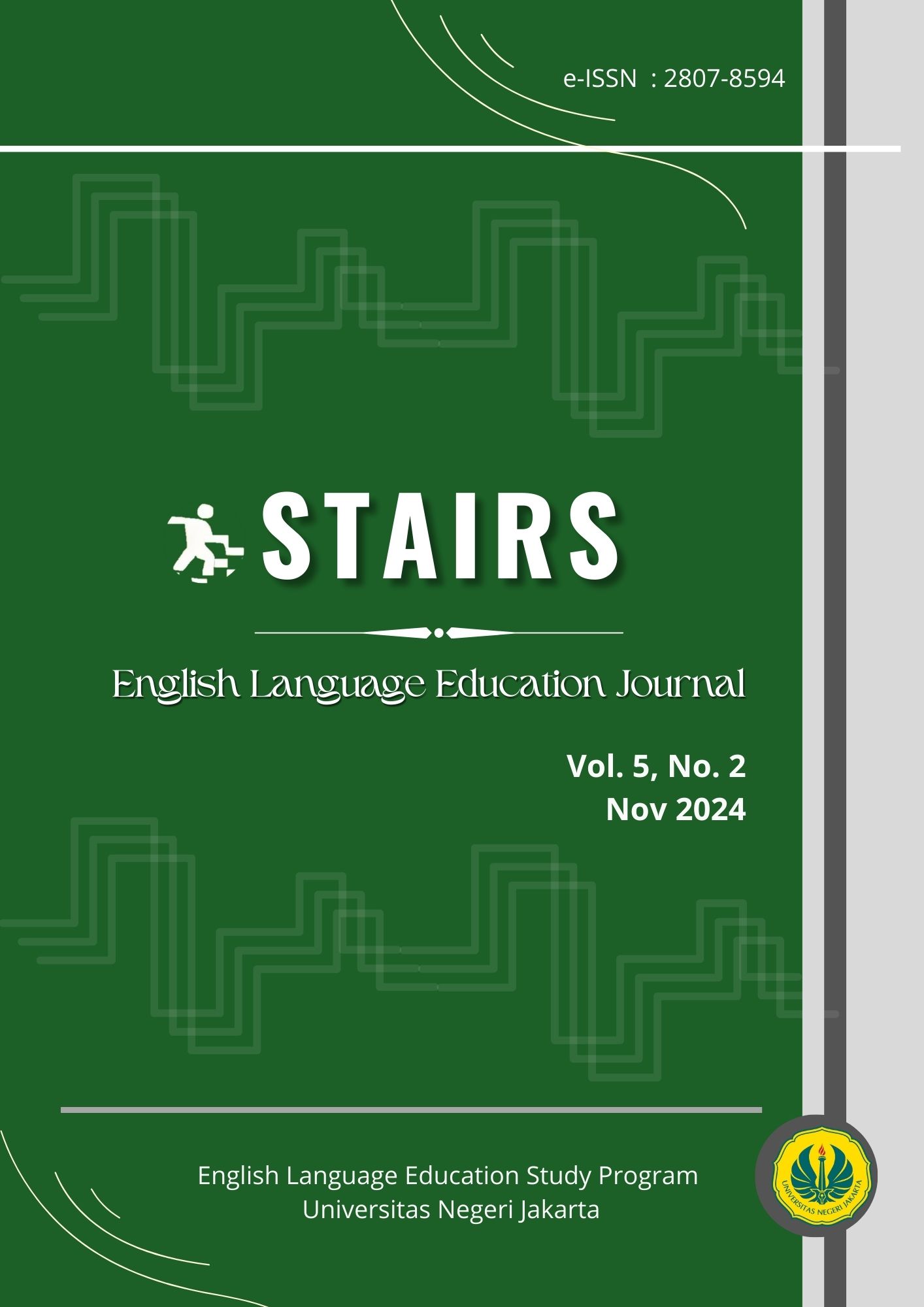An Analysis of Figurative Languages in the Niki Zefanya’s Song Lyrics
DOI:
https://doi.org/10.21009/stairs.5.2.2Keywords:
Figurative languages, Semantic meaning, Song lyric analysisAbstract
Language and music are deeply interconnected, enabling artists to express emotions and abstract ideas creatively. While figurative language is a key element in literary and musical compositions, limited research has examined how emerging contemporary musicians employ it to enhance lyrical expression. This study investigates the use of figurative language in three selected songs by Niki Zefanya. Using a qualitative approach with textual analysis, this research identifies and categorizes figurative devices present in the lyrics. The findings reveal five types of figurative language: metaphors and hyperboles as the most dominant, followed by irony, synecdoche, and repetition, each contributing to the emotional and thematic depth of the songs. These results highlight the role of figurative language in shaping meaning, enhancing artistic expression, and deepening listeners’ engagement with song lyrics. This study contributes to the fields of stylistics and discourse analysis by offering insights into the intersection of language and music, demonstrating how figurative language functions as a communicative tool in contemporary songwriting.
References
Abrams, M. H., & Harpham, G. G. (2012). A Glossary of Literary Terms (10th ed.). Cengage Learning.
Agustina, A.E., & Mustikawati, Y. (2023). Analysis of figurative language in song lyrics “Make It Right” and “Permission to Dance” by BTS. Eliterate: Journal of English Linguistics and Literature Studies, 3(1), 23-31.
Amirulloh, R. K., Suryanto, B., & Lestari, P. Y. (2023). Analysis on figurative language styles in business news of The Times website. Proceedings of the International Virtual Conference on Language and Literature (IVICOLL, 3, 158–164.
Aras, B., Bozkurt, S., & Önen, S. (2024). Exploring figurative language usage in contemporary music: Pedagogical implications for English language instruction. Novitas-ROYAL (Research on Youth and Language), 18(2), 29–51. https://doi.org/10.5281/zenodo.13860646
Banaruee, H., Khoshsima, H., Zare-Behtash, E., Yarahmadzehi, N., & Zhang, L. J. (2019). Types of metaphors and mechanisms of comprehension. Cogent Education, 6(1). Https://Doi.Org/10.1080/2331186x.2019.1617824
Cann, R. (1993). Formal Semantics: An Introduction. Cambridge University Press.
Fadilla, D. A. N. N., Ariani, S., Max, J. I. S. D. (2023). A Stylistic analysis of figurative language in Ariana Grande’s song lyrics. Jurnal Bahasa, Sastra, Seni, dan Budaya, 7(4), 1301-1312.
Fitria, E. (2018). Figurative language used in One Direction's album entitled Up All Night. [Unpublished master's thesis]. Universitas Negeri Semarang.
Ilham, I., & Akhiruddin, A. (2022). Analisis gaya bahasa retoris dan gaya bahasa kiasan dalam pidato Nadiem Makariem. Gurindam: Jurnal Bahasa Dan Sastra, 2(1), 53-63. Http://Dx.Doi.Org/10.24014/Gjbs.V2i1.16556
Jati, L. J. W. (2020). Metaphors in Bring Me the Horizons selected song lyrics. UC Journal: ELT, Linguistics and Literature Journal, 1(1), 37–59. Https://Doi.Org/10.24071/Uc.V1i1.2847
Koçak, C. B., & Atalık, Ö. (2024). Figurative language effect on consumer engagement: An empirical investigation for Turkish airline industry. Aviation, 28(2), 128–140. https://doi.org/10.3846/aviation.2024.21676
Kroeger, P. R. (2018). Semantics: A Coursebook (2nd ed.). Cambridge University Press.
Kusumahwati, L., Andriani, N., Degeng, P., & Hamamah, H. (2023). Analyzing figurative language in Niki’s song lyrics to teach listening comprehension for EFL learners. Proceedings of the 2nd International Conference on Language, Literature, Education, and Culture, ICOLLEC. Https://Doi.Org/10.4108/Eai.11-11-2022.2329348
Lakoff, G., & Johnson, M. (1980). Metaphors We Live by. University of Chicago Press.
Li, B., Weinberger, K. Q., Belongie, S., Koltun, V., & Ranftl, R. (2022). Language-driven semantic segmentation. Arxiv Preprint Arxiv:2201.03546. Https://Arxiv.Org/Abs/2201.03546
Maulud, D. H., Zeebaree, S. R., Jacksi, K., Sadeeq, M. A. M., & Sharif, K. H. (2021). State of art for semantic analysis of natural language processing. Qubahan Academic Journal, 1(2), 21-28. Https://Journal.Qubahan.Com/Index.Php/Qaj/Article/View/44
Nafinuddin, S. (2020). Majas (Majas Perbandingan, Majas Pertentangan, Majas Perulangan, Majas Pertautan).
Nurajizah, S. (2021). Penggunaan majas dalam novel Satu Hari di 2018 karya Boy Candra. Diksatrasia: Jurnal Ilmiah Pendidikan Bahasa Dan Sastra Indonesia, 5(2). Http://Dx.Doi.Org/10.25157/Diksatrasia.V5i2.7244
Nurwahida & Mustikawati, Y. (2022). Figurative languages in BTS songs lyrics. ELITERATE: Journal of English Linguistics and Literature Studies, 2(3), 60–70.
Pardede, M., Saragi, C. N., & Sidabutar, U. (2023). Metaphor analysis in songs lyrics of Charlie Puth: A case on semantics. Jurnal Scientia, 12(04), 471-478.
Perrine, L. (1969). Sound and Sense: An Introduction to Poetry (4th ed.). Harcourt Brace Jovanovich.
Purati, S., Mulyono, T., & Khotimah, K. (2022). Penggunaan majas personifikasi pada novel Ratu Berlian dan implikasinya sebagai bahan ajar di SMP. Perisai, 1(1), 173-180. Https://Semnas.Upstegal.Ac.Id/Index.Php/Perisai/Article/Download/459/203
Putri, S. A. (2023). Tilikan unsur citraan dan majas repetisi pada puisi "Lagu Gadis Italy" karya Sitor Situmorang. Pustaka: Jurnal Bahasa Dan Pendidikan, 3(1), 13-18. Https://Doi.Org/10.56910/Pustaka.V3i1.277
Salwia, F., Syahbuddin, S., & Efendi, M. (2022). Analisis majas dalam novel Pasung Jiwa karya Okky Madasari. Jurnal Ilmiah Profesi Pendidikan, 7(4), 2228-2231. Https://Doi.Org/10.29303/Jipp.V7i4.937
Siagian, Y. E. B., & Englishtina, I. (2022). An analysis of figurative language used in the song lyrics in the Moana movie. Inti Englishtina, 3(1), https://dx.doi.org/10.56444/lime.v3i01.2903
Wibowo, H., & Handayani, V. (2023). Morphological analysis in Snow White and the Seven Dwarfs story. Teaching English As Foreign Language, Literature And Linguistics, 3(2), 37-44. Https://Doi.Org/10.33752/Teflics.V3i2.5282
Wibowo, H., & Ramadhani, N. L. (2024). An analysis of euphemism in the captions of folkative Instagram accounts. Tamaddun, 23(1), 78-97. Https://Jurnal.Fs.Umi.Ac.Id/Index.Php/Tamaddun-Life/Article/View/669



